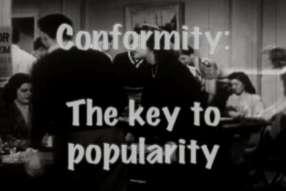 Pre-Kind Of Blue, that is 1959, Conformity was a way of seeking acceptance in America. Jazz musicians needed to make clear the fierce intelligence that was necessary to play [jazz]. The greater society thought of jazz as merely an offshoot of the so-called natural sense of rhythm of African-Americans and believed that it lacked the sophistication of classical music." Conformity was seen as the key to success in America for many African-Americans in general and jazz musicians in particular. Because of this comparison to classical music, "Harmonic complexity became a hallmark of modern jazz." "The rhythms and…melodies of jazz can be traced to Africa. But the use of chords comes out of the European harmonic system."
Pre-Kind Of Blue, that is 1959, Conformity was a way of seeking acceptance in America. Jazz musicians needed to make clear the fierce intelligence that was necessary to play [jazz]. The greater society thought of jazz as merely an offshoot of the so-called natural sense of rhythm of African-Americans and believed that it lacked the sophistication of classical music." Conformity was seen as the key to success in America for many African-Americans in general and jazz musicians in particular. Because of this comparison to classical music, "Harmonic complexity became a hallmark of modern jazz." "The rhythms and…melodies of jazz can be traced to Africa. But the use of chords comes out of the European harmonic system."
"…by the late 1930's and early 1940's, there was a restlessness in jazz that would begin gradually and grow to enormous proportions by the time it reached its culmination in the 1950's and 1960's. And with black soldiers fighting a war against racism and fascism in Europe, the idea of returning to a home country in which they were themselves oppressed fanned new winds of change." "Many began to question whether European tradition was the only yardstick they had with which to measure their own music…Many jazzmen began to wonder whether trying to achieve the harmonic complexity of classical music was a desired goal after all."
Kind of Blue was a break from the status quo, a protest…an emergence.
For theology to become Jazz Theology there must be a moment of protest and resistance (and eventually convergence). Walter Brueggemann writes, "the task of prophetic ministry is to nurture, nourish, and evoke a consciousness and perception alternative to the consciousness and perception of the dominant culture around us." (The Prophetic Imagination, p3)
"The contemporary American church is so largely enculturated to the American ethos of consumerism that it has little power to believe or to act." (Brueggeman, p1)
How does this effect your theology?
We must emerge…more than that, we must converge.
(All quotes above are from Eric Nisenson's fine book, "The Making of Kind of Blue")

